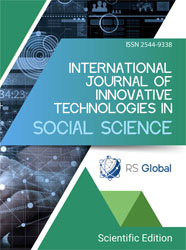THE CENTRALITY OF THE LIVING FRAMEWORK AND ITS IMPLICATIONS FOR THE QUALITY OF URBAN LIFE: THE CASE OF THE OLD CITY OF CONSTANTINE
Abstract
Living in cities imposes a rapid lifestyle subject to the laws and requirements of living in them, as the latter provide the needs of their inhabitants in varying proportions, and city centres are considered the most important living areas. Through this article, we will try to know the relationship between the quality of urban life and the centralized living areas through a field investigation where 50 questionnaires were distributed to the inhabitants of Souika with the help of two elementary schools. After transcribing and analysing the results, it was found that despite the weight of the historical past in every detail of its corners and the services it provides through it or through its surroundings, and despite the deteriorating state of its built framework, which has negatively affected the inhabitants in many aspects of their daily lives, it is still for them the preferred living framework that fulfils their needs and makes them comfortable and satisfied them and shows their attachment to it and their sense of belonging. This is what makes the overall centrality of the old city, including the historical one, not opposed to achieving the quality of urban life in this particular living framework.
References
Charles Girard, Tangi Le Dantec (2016), Bien vivre la ville et si la ville favorisait la santé et le bien-être? (Fondation AIA, Architecture, santé, environnement), Archibook +Sautereau Edition, pp.48-50.
Fouad ben ghodbane (2015), quality of life in urban communities, diagnostics, indicators, evaluation, al dar al manhajia, Oman, Jordan, p. 32.
Max Craglia et autres (Mai 1999), Evaluer la qualité de la vie dans les villes et régions européennes, Conceptualisation Théorique, indicateurs classiques et innovation , CdR, Etudes E, 3/99, Bruxelles, p.14.
Natalia Barbarino-Saulnier (8 juin 2005), De la qualité de vie au diagnostic urbain, thèse de doctorat en Géographie Aménagement et Urbanisme, Université Lumière Lyon 2, Faculté de géographie, Histoire, Histoire de l’Art et Tourisme, Département de géographie, Institut d’urbanisme de Lyon, Tome 1 Tome 2, p.04 http://theses.univlyon2.fr/documents/lyon2/2005/barbarino_n#p=0&a=title
Pierre Sansot (2017) (préface d’Olivier Mongin):La marginalisation urbaine, Édition Payot et Rivages, Paris, p.18.
Bouadam Roukia-Ghiat (juin 2009), Le devenir du centre ville de Constantine: une histoire de controverse, département de génie civil, Université du 20 août 55 Skikda, Al-Bahit Al-ijtima’i, N° 09, p.08.
Schéma de Cohérence Urbaine de Constantine, rendu mission 3 (juin 2007), (enjeux majeurs du SCU du grand Constantine, projet d’aménagement et de développement à l’horizon 2025 de Constantine, ville et métropole renouvelées, Groupement URBACO-EDR, pp.21-26.
Khalaf Hussein Ali Al-Dulaimi (2009), community service planning and infrastructure, foundations, criteria, techniques, dar assafa, pp. 51-52.
Jean-Jacques Bavous (2010), Initiation à l’analyse spatiale, Armand Colin, Paris, p.56.
Ministère de la culture, direction de la culture, Wilaya de Constantine ,PPSMVSS vieille ville de Constantine, phase I, diagnostic et mesures d’urgence, rapport de la première phase (mai 2009), BET J.Kribeche, ELP.
Ministère de la culture, direction de la culture, Wilaya de Constantine, PPSMVSS vieille ville de Constantine, phase III, rédaction finale du PPSMVSS,(octobre 2012) rapport de présentation, BET Jennie Kribeche ,p.15.
Bitam Amina (2011-2012), Le centre de Constantine entre bazardization et patrimonialisation, la gentrification, une solution, Mémoire de magister en urbanisme, option: villes et projet urbain, Université Mentouri Constantine, p.186. https://theses-algerie.com/9774699283724803/memoire-de-magister/universite-freres-mentouri---constantine-1/le-centre-de-constantine-entre-bazardisation-et-patrimonialisation-la-gentrification-une-solution.
Law n 13/08 historin in 30 december, 2013 the finance law 2014 includes, n 68, official gazette, issued in 31 december2013 .
Fantazi Imane (2020-2021), Le management des opérations de conservation du patrimoine bâti en Algérie dans un contexte événementiel: cas de la vieille ville de Constantine capitale de la culture arabe 2015, département de management de projets, Faculté d’architecture et d’urbanisme, Université Constantine 3,p.38.https://hal.science/tel-03354393.
Gabriel Moser et Karine Weiss (2003), Espaces de vie, aspects de la relation homme-environnement, Armand Colin, Paris, p.201.
Guy Burgel (2017), Questions urbaines, L’Aube, p.63.
Views:
120
Downloads:
100
Copyright (c) 2025 Senani Karima, Bousmaha Ahmed

This work is licensed under a Creative Commons Attribution 4.0 International License.
All articles are published in open-access and licensed under a Creative Commons Attribution 4.0 International License (CC BY 4.0). Hence, authors retain copyright to the content of the articles.
CC BY 4.0 License allows content to be copied, adapted, displayed, distributed, re-published or otherwise re-used for any purpose including for adaptation and commercial use provided the content is attributed.











